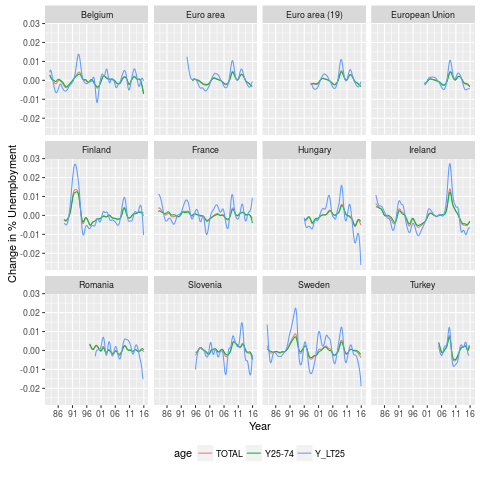Code
There are many ways to set this up. I wanted some plots. My first approach; given an observed proportion of 'correct', how does the total of trials change the intervals? The second approach; given that a certain number of trials is done, how do the intervals change as the number correct changes?Since I want to repeat many of these calculations, I first made some supporting functions. This is because I am trying to write more clear code, where as much as possible code is not repeated but rather delegated to some sort of function. That may not result in the shortest or fastest code, but at this point neither is required.
Intervals
The first functions create the intervals from n (observed) and N (total). Clopper-Pearson is extracted from binom.test(). Normal approximation is based on an internet example. Beta-Binomial has three functions, one for the actual work, two to set up the desired priors and adapt the naming. A final function calls all these.
clopper.pearson <- function(n,N,conf.level=0.95) {
limits <- as.numeric(binom.test(n,N,conf.level=conf.level)$conf.int)
names(limits) <- c('cp_low','cp_high')
limits
}
binom.norm.app <- function(n,N,conf.level=0.95) {
# based on http://www.r-tutor.com/elementary-statistics/interval-estimation/interval-estimate-population-proportion
phat <- n/N
shat <- sqrt(phat*(1-phat)/N)
limit <- (1-conf.level)/2
zlim <- qnorm( c(limit,1-limit))*shat
limits <- phat+zlim
names(limits) <- c('na_low','na_high')
limits
}
beta.binomial <- function(n,N,conf.level=0.95,prior=c(1,1)){
limit <- (1-conf.level)/2
limits <- qbeta(c(limit,1-limit),n+prior[1],N-n+prior[2])
names(limits) <- c('bb_low','bb_high')
limits
}
beta.binomial11 <- function(n,N,conf.level=0.95) {
limits <- beta.binomial(n,N,conf.level=conf.level,prior=c(1,1))
names(limits) <- c('bb11_low','bb11_high')
limits
}
beta.binomial.5.5 <- function(n,N,conf.level=0.95) {
limits <- beta.binomial(n,N,conf.level=conf.level,prior=c(0.5,0.5))
names(limits) <- c('bb.5_low','bb.5_high')
limits
}
all.intervals <- function(n,N,conf.level=0.95) {
c(n=n,N=N,conf.level=conf.level,
clopper.pearson(n,N,conf.level=conf.level),
binom.norm.app(n,N,conf.level=conf.level),
beta.binomial11(n,N,conf.level=conf.level),
beta.binomial.5.5(n,N,conf.level=conf.level))
}Post processing
Just doing an sapply() on all.intervals() gives a matrix. It needs to be processed a bit to get a nice data.frame which ggplot likes. Hence a function in which it is transposed, reshaped and names of the intervals are split. Naming is adapted for display purposes.
postprocessing <- function(have1outN) {
have1outN <- as.data.frame(t(have1outN))
have1outN <- reshape(have1outN,
varying=list(names(have1outN)[-1:-3]),
idvar=c('n','N','conf.level'),
timevar='statistic',
times=names(have1outN)[-1:-3],
v.names='limit',
direction='long')
have1outN$direction <-
sub('^.+_','',have1outN$statistic)
have1outN$Method <-
sub('_.+$','',have1outN$statistic)
have1outN$Method[have1outN$Method=='cp']<- 'Clopper Pearson'
have1outN$Method[have1outN$Method=='na']<-'Normal Approximation'
have1outN$Method[have1outN$Method=='bb.5']<- 'Beta Bionomial prior 0.5 0.5'
have1outN$Method[have1outN$Method=='bb11']<- 'Beta Bionomial prior 1 1'
have1outN
}
Results
Results for a proportion correct
The codes are variations on this example for 50% correct. As most of the work is done in the supporting functions, there is no need to repeat the code:
have1outN <- sapply(1:20,function(x) all.intervals(1*x,2*x))
have1outN <- postprocessing(have1outN)
ggplot(have1outN,aes(x=limit,y=N,col=Method,l=direction)) +
geom_path() +
xlim(c(min(0,have1outN$limit),max(1,have1outN$limit))) +
ggtitle('Interval at 1/2 correct') +
theme(legend.position="bottom") +
guides(col=guide_legend(ncol=2))
It seems that especially at lower N the Normal approximation is not advisable. Having an interval stick outside the range 0-1 is obviously a dead giveaway that something is not correct. But even if that does not happen, the lines are pretty far of the remainder of the methods. The difference between the two Beta Binomials is surprisingly small and only visible when very few observations are made. Clopper-Pearson seems to give slightly wider intervals than Beta Binomial.
Results for a fixed N
Again, the code is variations on a theme, with the work being done by the supporting functions.
Again the normal approximation is the odd out. It also seems to degenerate at n=0 and n=N. Other than that the choice of prior in the Beta Binomial is more expressed that the previous plots.










